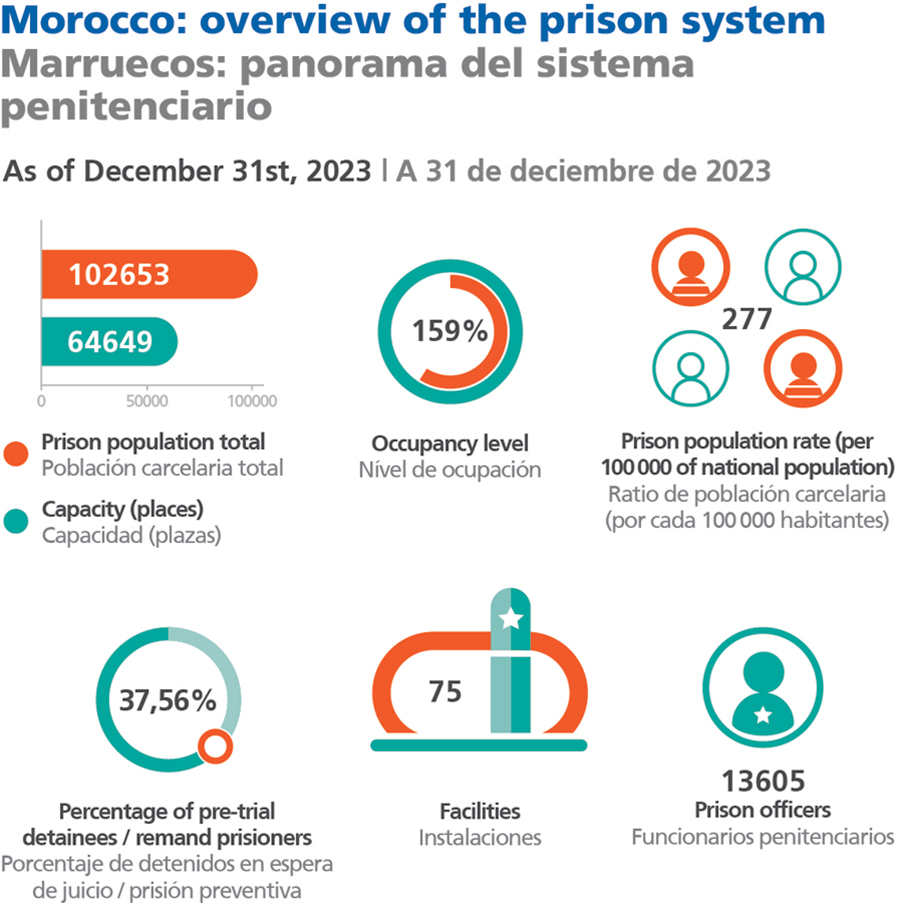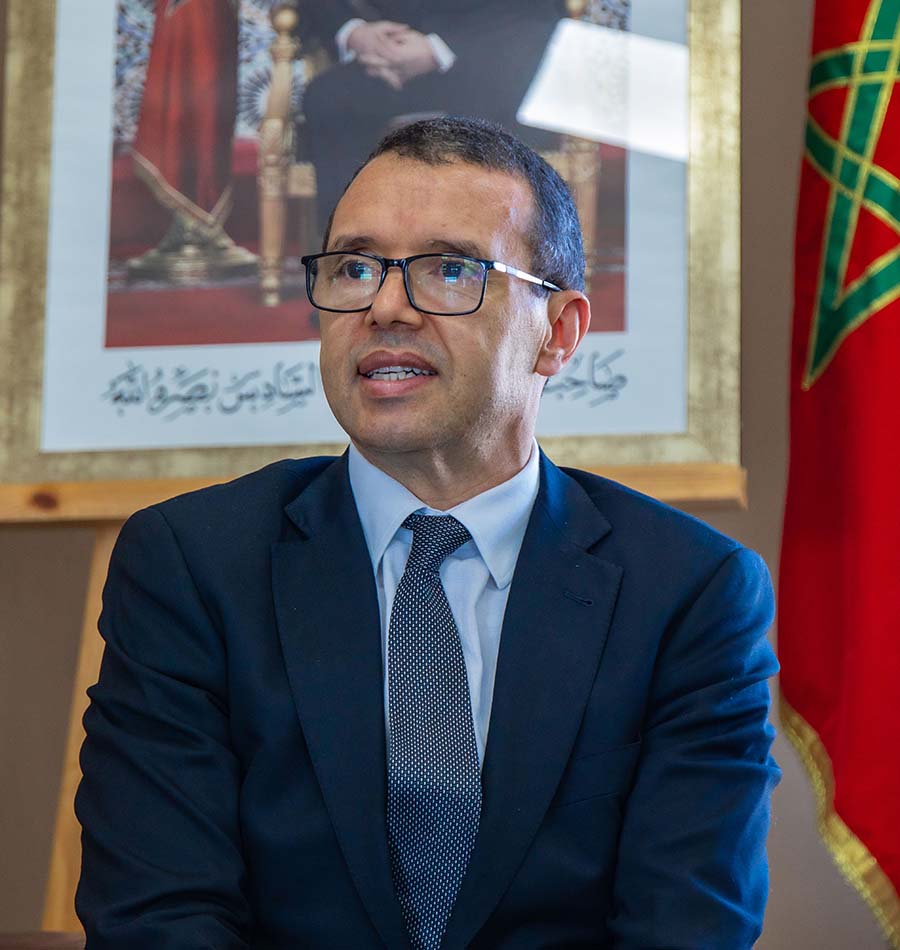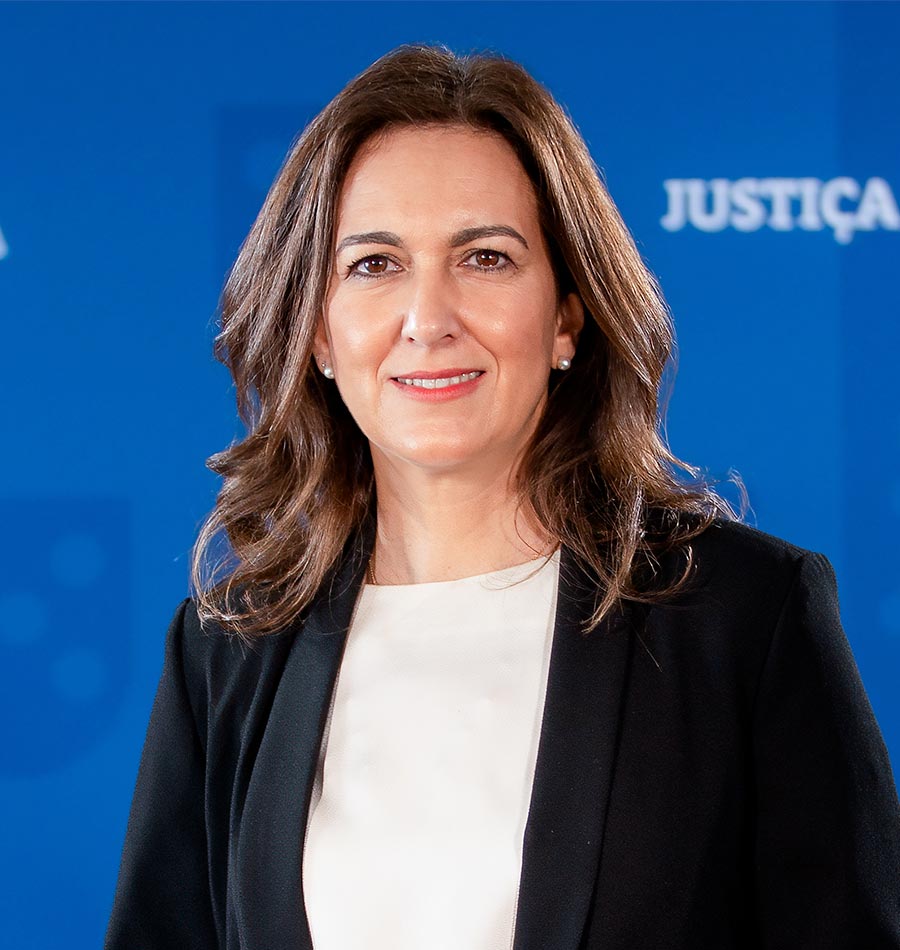Interview
Younes Jabrane
Secretary General of the General Delegation for Prison Administration and Reintegration, Kingdom of Morocco
What are the most pressing challenges faced by Morocco’s prison system today, and how is the General Delegation for Prison Administration and Reintegration prioritising its response to these issues?
YJ: Any objective observer can testify to the high level of development that has been reached by the Prison Administration and Reintegration department over the past 25 years in terms of modernising prison management and inmate reintegration programmes as well as the resources that have been put in place to achieve these undertakings.
However, overcrowding continues to be undoubtedly the primary concern and the most trying task for most correctional departments around the world.
The DGAPR has been equally affected by its far-reaching implications. And the causes are often diverse and countless.
The recent unprecedented sharp rise in our overall prison population caused serious alarm and reminded us of the need to take immediate action to halt this upsurge.
To do so, it is necessary to reinforce vigilance to further maintain security in detention facilities, and for this, the safe and efficient deployment of correctional staff is required. Without these prerequisites, rehabilitation, which is of vital significance, would be nothing more than an elusive goal.
Numerous factors have led to the excessive inmate numbers in Moroccan prisons, and they are the result of an inadequate national penal policy. Currently, the high prison population density only continues to worsen, as evidenced by the total number of prisoners, which has experienced a clear upward trend over the last decade, increasing from 87,799 prisoners at the end of July 2021 to 100,900 in April 2024, exceeding the average housing capacity of correctional facilities.
It is worth noting that overcrowding is one of the causes of the numerous assaults taking place between inmates, and it hinders any efforts made to ensure proper housing conditions and enhanced service delivery for inmates. As a result, a very large proportion of inmates lack access to rehabilitation and reintegration programmes and to appropriate healthcare.
The shortage of financial and human resources makes it an even more daunting task for the DGAPR to address overcrowding. Budget allocations are insufficient to respond to our priorities for inmate management and the implementation of reintegration programmes.
The lack of financial resources acts as an impediment not only to accelerating reforms of the penitentiary system but also to the construction of an adequate number of prisons according to the latest standards of facility planning. The success of any reintegration programme and the maintenance of safety and security depends on the availability of necessary assets and an optimal staff ratio.
Notwithstanding these constraints, the General Delegation continues to dedicate substantial effort to advocating for the improvement of the financial condition of the staff members.
What immediate actions are being prioritised to mitigate overcrowding in Moroccan prisons, and what long-term strategies are necessary to address this issue?
YJ: When our prison population reached the alarming average of 100,000 inmates, it was a grim wake-up call for us. At that juncture, a high-level committee was established consisting of stakeholders from distinct relevant departments to outline a multi-layered roadmap to address this issue.
Firstly, the DGAPR is required to continue its sustainable approach of building state-of-the-art penitentiary institutions that meet modern international standards, closing old facilities considered unfit for inmate accommodation, and remodelling or renovating others to further humanise the prison environment and offer better detention conditions. The efforts undertaken by the DGAPR to overcome overcrowding have been targeted at ensuring 3 square meters of living space per inmate. Therefore, from 2014 until now, 26 correctional facilities have been built in an attempt to ease prison congestion.
The committee also emphasised the importance of enforcing existing legal provisions as a means of reducing the use of imprisonment. They also proposed providing stakeholders with more effective tools to ensure that justice is served more efficiently.
Lastly, they pressed for the quick implementation of important changes to the law, namely amending the draft penal code and the introduction of the alternative sentences law.
Regrettably, the DGAPR is nowhere near reaching the internationally prescribed standard, since the current allocated habitable floor for each inmate amounted to no more than 1.75 square meters at the end of 2023 due, once again, to excess numbers, which increase at a rate of 5% each year.
An overhaul of the penal policy therefore must be considered from a penal and legislative perspective to decriminalise certain minor offences and innocuous misdemeanours, along with the need to broaden the scope of felonies receiving alternative sentences.
How effective can this new legal framework introducing alternative sentences be in contributing to decongesting prisons and facilitating better rehabilitation outcomes, and what measures are in place to ensure their effective roll-out?
YJ: First of all, it is important to point out that, at the time of this interview, the law on alternative sentences is thus far subject to ratification only by the lower chamber of parliament pending final bi-chamber endorsement.
From my viewpoint and that of many observers, the implementation of sentences involving alternatives to imprisonment may face certain impediments. Given the various types of alternatives stipulated by the draft law in question, namely community service, daily fines, electronic surveillance, and the restriction of certain rights, such as those of movement and travel, stakeholders lacking an advanced command of these sorts of unconventional sentencing will face a daunting task.
Even more disconcerting is the scarcity of the required technical tools when it comes, for instance, to electronic tagging, while considering the duty to assume the annual maintenance and operating costs; not to mention the need for sufficient trained staff. In light of all of this, crucial resources must be rallied for optimum and sustainable management of this matter.
Yet, assuming that alternative sentences are applied, their impact on overcrowding will remain very limited for two reasons. Firstly, alternative sentences will only be applied to petty offences having sentences that do not exceed 5 years, according to criteria specified by law.
Then, even countries that are backed up by the most appropriate and sustainable resources in terms of funding, staff numbers, training and equipment have not managed to reduce their prison population, even with systematic enforcement of alternatives. It is therefore logical that this type of sanction will not be a simple task when it comes to addressing prison overpopulation.

JT: Morocco has developed a 2022-2026 strategy plan to improve and humanise conditions within detention facilities as well as bolster efforts for societal reintegration.
Can you share some of the key achievements or efforts underway to modernise infrastructure, prison management and reinforce staff training and development?
YJ: Overall, the strategic plan aims to provide new momentum to the DGAPR and achieve better levels of efficiency. It is based both on a human rights approach and gender equality.
We have implemented programmes that proved to be efficient, making the detention premises more humane, which may have a positive impact on inmate reintegration and the reduction of overcrowding, while ensuring partial coverage of the Kingdom’s judicial map.
Since 2015, the DGAPR has implemented a comprehensive plan based on human resources that has clear objectives and specific indicators.
This plan includes the concept of risk. Along with the launch of the strategic plan for the 2022-2026 period, the DGAPR created a dashboard containing monitoring indicators that enhance sporadic and systematic evaluation of the yielded results. Within the same context, we proceeded to upgrade the risk matrix, with the aim of assessing the factors that are an obstacle in the way of reaching our goals, such as the increasing number of inmates.
The DGAPR has also agreed to promote and enhance the digitalisation process through the implementation and generalisation of our integrated computer system (IDS) to all correctional facilities.
As far as staff training is concerned, the strategy currently being adopted by the DGAPR is based on a wide-ranging plan intended to provide correctional personnel with manifold skills. Through enhanced data management we are improving the methods of personnel management. Biometric technology is now being adopted at all correctional facilities to monitor inmates’ identity and motion.
The 2022-2026 plan involves sustainable collaboration with the competent bodies to explore avenues to enact the draft decree amending the Special Status of DGAPR staff to enhance their economic conditions. In terms of reintegration, programmes are based on the individualisation of sentences, tailored to the characteristics and the needs of each category of offenders. For instance, the strategic plan provided for the implementation of an innovative Moussalaha (reconciliation in Arabic) reintegration project directed at inmates convicted of terrorism-related offences. The programme’s success has led to the creation of a centre having the same name.
JT: On the sidelines of the first meeting of the executive committee of the Association of African Correctional Services (ASCA), held in Rabat earlier this year, Morocco and Senegal came together to sign a cooperation protocol aimed at bolstering training and experience exchange in the realm of prison management and rehabilitative programmes
How crucial is international cooperation and engagement through organisations such as ASCA?
YJ: Given DGAPR’s training infrastructure, it has become a regional hub receiving delegations each year from penitentiary administrations of Africa and the MENA region. Our staff also conduct training sessions in some countries of these regions on behalf of their personnel.
An important aspect of this partnership was the organisation of the African Forum in 2020 in Rabat, which brought together countries from the African continent. The agreement signed with Senegal is one of a series of conventions concluded with other African countries. The DGAPR also continues to explore best practices in terms of prison management across the globe and it aims to establish further partnership ties with relevant counterparts and with non-governmental organisations and UN bodies.
The DGAPR has also developed strong links with professional associations such as the International Corrections and Prisons Association (ICPA) and the American Correctional Association (ACA) with a view to undertake joint actions in the field of corrections. The General Delegation advocates openness and partnership and continues to work for the improvement of prison management and to promote a culture of human rights in prisons.
Younes Jabrane
Secretary General of the General Delegation for Prison Administration and Reintegration, Kingdom of Morocco
Younes Jabrane has been the Secretary General of DGAPR since 2015. He holds a master’s degree in New Public Management and has a strong background in strategic planning and project implementation. Mr Jabrane has been an active participant in several committees focusing on administrative reforms. Previously, he was a senior executive of the General Inspectorate of Territorial Administration (1996-2003), under the Moroccan Ministry of Interior, and Project Director at the Agency for the Promotion and Social and Economic Development of the Southern Provinces of the Kingdom of Morocco from 2003 to 2015.
Advertisement



